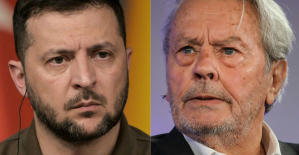The Bundeswehr is getting closer to using laser weapons as a new type of weapon without classic ammunition. For the first time, a German warship has engaged several drones at close and close range in tests with a high-energy laser weapon. The tests on board the frigate Sachsen on the Baltic Sea coast in front of the Putlos military training area took place in August, but have only now been published.
The armaments company MBDA Germany does not provide any details, such as the number and size of the drones fought. "The first tests were successful," explains MBDA Germany boss Thomas Gottschild in an interview with WELT.
It is still a long time before the troops can be used regularly. The laser weapon now integrated in a container is a so-called demonstrator, a kind of prototype. MBDA Germany and the armaments group Rheinmetall have been working together on the project since mid-2020, have invested millions and are now hoping for a bid from the federal government. The new weapon system is particularly suitable for defending against drones, drone swarms or attacking speedboats at close range, says MBDA Germany boss Gottschild.
Tests running until next year are intended to narrow down the future range of tasks and ranges. "The technology base is mature and we could start product development," says Gottschild.
The threat posed by drones is currently evident in the war in Ukraine. The head of MBDA Germany left open whether the German high-energy laser would already be able to shoot down the Shahed-136 kamikaze drones, which most likely originated in Iran and are currently attacking targets in Ukraine.
As Gottschild says, based on the developments of the demonstrator, the performance of the laser weapon could be significantly increased. Then even guided missiles or mortar shells could be destroyed on approach. Laser weapons could not only be installed on naval ships, but in the future also on land vehicles or, with miniaturization, even on aircraft.
The laser demonstrator now used has an output of 20 kilowatts. This is significantly less than the US laser cannons currently in development, which the US Navy demonstrated years ago in field tests. China and Russia are also working on laser weapons. However, the head of MBDA Germany does not see a serious deficit. "We see ourselves as a technological leader and at the top in Europe," says Gottschild. The laser weapons used by other countries are also demonstrators and not yet fully developed products.
One of the special features of the German laser weapon is that the competing companies MBDA and Rheinmetall are working together on the project, although both companies have previously pushed ahead with their own laser developments. As early as 2018, Rheinmetall tested a laboratory sample of a 20-kilowatt laser source with the Bundeswehr procurement authority BAIINBw. MBDA has also invested heavily in technology for years. The development of a laser weapon with an output of 100 kilowatts was mentioned several times by the companies as a prospect.
MBDA Germany boss Gottschild sees laser weapons as a complement to classic barrel cannons. "The laser is highly agile, quick and flexible to use," he says. Laser technology would have the advantage that there would be no dangerous splinters from exploding ammunition, i.e. airburst ammunition, as experts call it.
An advantage of laser weapons is also the higher speed compared to spent ammunition and theoretically an "infinite magazine" because there is no need to store ammunition. However, laser weapons have a high power requirement and need cooling.
One of the advantages of laser weapons is that they are extremely accurate. For example, only the optics of attacking drones could be switched off. "The technology is demanding," says Gottschild. “For example, the laser beam has to hit a moving target point the size of a two-euro coin at a distance of one or two kilometers. We now have this technology under control.” Investments have been made in the technology over the years. In the demonstrator, the laser source and beam guidance come from Rheinmetall and the target tracking, user interface and intelligence of the system from MBDA Germany.
"Everything on shares" is the daily stock exchange shot from the WELT business editorial team. Every morning from 5 a.m. with the financial journalists from WELT. For stock market experts and beginners. Subscribe to the podcast on Spotify, Apple Podcast, Amazon Music and Deezer. Or directly via RSS feed.

 Sydney: Assyrian bishop stabbed, conservative TikToker outspoken on Islam
Sydney: Assyrian bishop stabbed, conservative TikToker outspoken on Islam Torrential rains in Dubai: “The event is so intense that we cannot find analogues in our databases”
Torrential rains in Dubai: “The event is so intense that we cannot find analogues in our databases” Rishi Sunak wants a tobacco-free UK
Rishi Sunak wants a tobacco-free UK In Africa, the number of millionaires will boom over the next ten years
In Africa, the number of millionaires will boom over the next ten years Can relaxation, sophrology and meditation help with insomnia?
Can relaxation, sophrology and meditation help with insomnia? WHO concerned about spread of H5N1 avian flu to new species, including humans
WHO concerned about spread of H5N1 avian flu to new species, including humans New generation mosquito nets prove much more effective against malaria
New generation mosquito nets prove much more effective against malaria Covid-19: everything you need to know about the new vaccination campaign which is starting
Covid-19: everything you need to know about the new vaccination campaign which is starting For the Olympics, SNCF is developing an instant translation application
For the Olympics, SNCF is developing an instant translation application La Poste deploys mobile post office trucks in 5 rural departments
La Poste deploys mobile post office trucks in 5 rural departments Meta accelerates into generative artificial intelligence with Llama 3
Meta accelerates into generative artificial intelligence with Llama 3 In China, Apple forced to withdraw WhatsApp and Threads applications at the request of the authorities
In China, Apple forced to withdraw WhatsApp and Threads applications at the request of the authorities The main facade of the old Copenhagen Stock Exchange collapsed, two days after the fire started
The main facade of the old Copenhagen Stock Exchange collapsed, two days after the fire started Alain Delon decorated by Ukraine for his support in the conflict against Russia
Alain Delon decorated by Ukraine for his support in the conflict against Russia Who’s Who launches the first edition of its literary prize
Who’s Who launches the first edition of its literary prize Sylvain Amic appointed to the Musée d’Orsay to replace Christophe Leribault
Sylvain Amic appointed to the Musée d’Orsay to replace Christophe Leribault Skoda Kodiaq 2024: a 'beast' plug-in hybrid SUV
Skoda Kodiaq 2024: a 'beast' plug-in hybrid SUV Tesla launches a new Model Y with 600 km of autonomy at a "more accessible price"
Tesla launches a new Model Y with 600 km of autonomy at a "more accessible price" The 10 best-selling cars in March 2024 in Spain: sales fall due to Easter
The 10 best-selling cars in March 2024 in Spain: sales fall due to Easter A private jet company buys more than 100 flying cars
A private jet company buys more than 100 flying cars This is how housing prices have changed in Spain in the last decade
This is how housing prices have changed in Spain in the last decade The home mortgage firm drops 10% in January and interest soars to 3.46%
The home mortgage firm drops 10% in January and interest soars to 3.46% The jewel of the Rocío de Nagüeles urbanization: a dream villa in Marbella
The jewel of the Rocío de Nagüeles urbanization: a dream villa in Marbella Rental prices grow by 7.3% in February: where does it go up and where does it go down?
Rental prices grow by 7.3% in February: where does it go up and where does it go down? With the promise of a “real burst of authority”, Gabriel Attal provokes the ire of the opposition
With the promise of a “real burst of authority”, Gabriel Attal provokes the ire of the opposition Europeans: the schedule of debates to follow between now and June 9
Europeans: the schedule of debates to follow between now and June 9 Europeans: “In France, there is a left and there is a right,” assures Bellamy
Europeans: “In France, there is a left and there is a right,” assures Bellamy During the night of the economy, the right points out the budgetary flaws of the macronie
During the night of the economy, the right points out the budgetary flaws of the macronie These French cities that will boycott the World Cup in Qatar
These French cities that will boycott the World Cup in Qatar Europa League: “We dream of everything,” says Jean-Louis Gasset
Europa League: “We dream of everything,” says Jean-Louis Gasset Europa League: “Trouble playing our football,” admits Benfica coach
Europa League: “Trouble playing our football,” admits Benfica coach Europa League Conference: “Martinez eats all your deaths”, Obraniak’s breakdown after the elimination of Lille
Europa League Conference: “Martinez eats all your deaths”, Obraniak’s breakdown after the elimination of Lille Premier League: “It’s a team that is transforming into the Champions League”, Casemiro returned to Real’s qualification
Premier League: “It’s a team that is transforming into the Champions League”, Casemiro returned to Real’s qualification


















